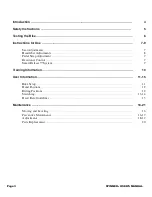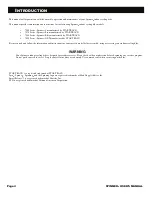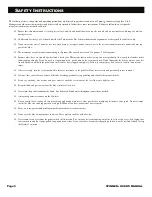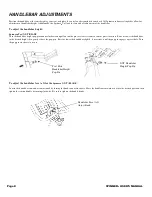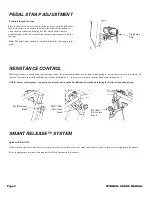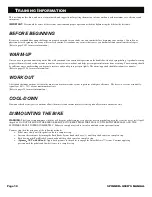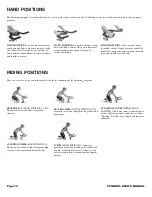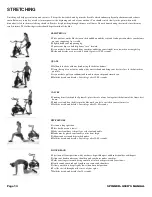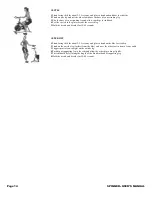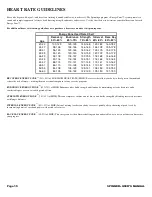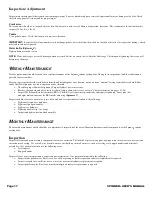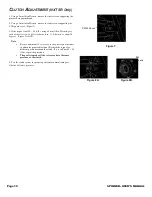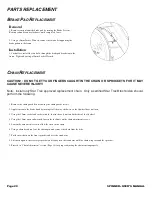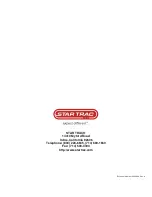
%"
Inspection / Adjustment
Inspect major moving parts that require constant proper torque. Loose or misadjusted parts can result in personal injury or damage to the bike. Check
the following parts for security and/or proper torque.
Crank arms
The crank arms should be re-torqued after the first 10 hours of use and every 100 hours of operation, thereafter. The crank arm to the bottom bracket
torque is 30 lbs-ft (± 3 lbs-ft).
Pedals
Use a pedal wrench. Verify that the pedal is not cross-threaded.
IMPORTANT:
If your facility allows members to interchange pedals, it is critical that the pedals are checked after each class to prevent damage, which
may lead to injuries if ignored.
Water bottle (Spinner
®
V)
Tighten down assembly screws.
NOTE:
Water bottle cages are easily damaged when oversized bottles are forced to fit within the bottle cage. Checking and tightening the screws will
help prevent damage.
W
EEKLY
M
AINTENANCE
Weekly maintenance should focus on the overall performance of the Spinner
®
indoor cycling bike. During these inspections, look for vibration and
possible loose assemblies.
Have an experienced rider ride each bike to identify and help diagnose any vibration, noises, and any "unusual" feeling from the drive chain. Either
faulty flywheel alignment or a loose chain can cause vibration.
o
Check for proper flywheel alignment. Torque flywheel nuts as necessary.
o
Remove chain guard and check for loose chain. Adjust chain as necessary (refer to "Chain Adjustment" on pages 23-24).
o
Inspect The Bottom Bracket Assembly (BBA). The BBA will come loose periodically and require tightening. Loose play (left
and right motion) indicates the BBA needs adjusting.
(Spinner
®
V)
Inspect each bike for loose assemblies, parts, bolts and nuts. Give particular attention to the following:
o
Tighten all frame base hardware.
o
Tighten all pull pin handles.
o
Tighten seat hardware.
o
Tighten pedal toe clip / toe straps.
o
Inspect and tighten tension knob assembly.
M
ONTHLY
M
AINTENANCE
The monthly maintenance check should be a comprehensive inspection of the overall frame and main assembly components of the Spinner
®
indoor
cycling bike.
Inspection
Inspect the frame and main assembly components for rust or corrosion. Tilt the bike or place in an upside down position to locate areas where rust and
corrosion may develop. Use a small, wire brush to remove rust build-up in small crevasses, such as leveling feet, pop pin handles and other bolt
assemblies. Give particular attention to the following areas:
o
Leveling feet
o
Pop pin handles
Inspect all wear items for adjustments or possible part replacement. Give particular attention to the following:
o
Inspect brake pad for wear. Excessive wear, such as glazing or leather separation, indicates replacement is required.
o
Inspect seat pad for wear. Rips, tears or excessive movement indicates replacement is required.
o
Inspect pedals for play. Excessive movement of pedals indicates replacement is required.

